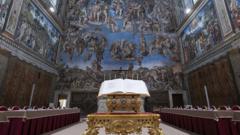Upon the historic backdrop of Michelangelo's masterpiece, the intricate voting process begins following a mass at St. Peter's Basilica, yielding both anticipation and secrecy as cardinals prepare for their sacred responsibility.
The election will kick off with a televised mass, presided over by Cardinal Dean Giovanni Battista Re, the venerable 91-year-old leader who officiated at Pope Francis' funeral. Following the spiritual service, which begins at 10:00 am local time, the Vatican will secure the area by disabling mobile signals to ensure confidentiality during the voting.
Around 4:15 pm, the 133 cardinal electors will form a procession to the Sistine Chapel, singing hymns and invoking the Holy Spirit for guidance. Once inside, they will take an oath of secrecy, pledging not to disclose details of the voting process. The phrase “extra omnes” will mark the beginning of the conclave, as Swiss guards secure the premises with lead seals to maintain the secrecy of deliberations.
Diego Ravelli, responsible for the proceedings, will distribute ballots for the initial vote, shedding light on potential leading candidates. Despite the historical trend leaning toward a closely contested process, cardinals will work to establish consensus. If a two-thirds majority is not reached, the cardinals will return to Casa Santa Marta for dinner, sparking further conversations that could influence candidate support.
From early morning breakfasts to additional votes scheduled in the following days, the cardinals remain aware that prolonged discussions could hint at deep divisions. Meanwhile, the anticipation builds outside the conclave's opaque windows, where faithful followers await the telltale plume of smoke, signaling the selection of a new pope.
With hopes resting heavily upon the participants, this conclave stands as a pivotal moment for the Catholic Church and its future leadership.
The election will kick off with a televised mass, presided over by Cardinal Dean Giovanni Battista Re, the venerable 91-year-old leader who officiated at Pope Francis' funeral. Following the spiritual service, which begins at 10:00 am local time, the Vatican will secure the area by disabling mobile signals to ensure confidentiality during the voting.
Around 4:15 pm, the 133 cardinal electors will form a procession to the Sistine Chapel, singing hymns and invoking the Holy Spirit for guidance. Once inside, they will take an oath of secrecy, pledging not to disclose details of the voting process. The phrase “extra omnes” will mark the beginning of the conclave, as Swiss guards secure the premises with lead seals to maintain the secrecy of deliberations.
Diego Ravelli, responsible for the proceedings, will distribute ballots for the initial vote, shedding light on potential leading candidates. Despite the historical trend leaning toward a closely contested process, cardinals will work to establish consensus. If a two-thirds majority is not reached, the cardinals will return to Casa Santa Marta for dinner, sparking further conversations that could influence candidate support.
From early morning breakfasts to additional votes scheduled in the following days, the cardinals remain aware that prolonged discussions could hint at deep divisions. Meanwhile, the anticipation builds outside the conclave's opaque windows, where faithful followers await the telltale plume of smoke, signaling the selection of a new pope.
With hopes resting heavily upon the participants, this conclave stands as a pivotal moment for the Catholic Church and its future leadership.




















